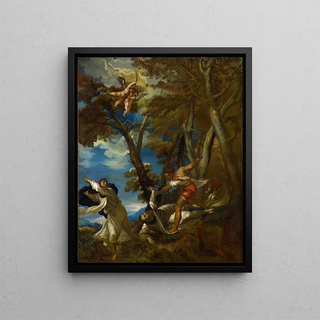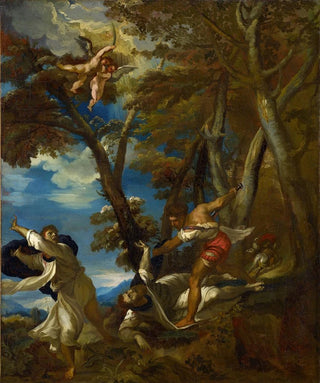Art print | The Martyrdom of Saint Peter - Théodore Géricault


View from behind

Frame (optional)
The Martyrdom of Saint Peter - Théodore Géricault – Captivating Introduction
In the vast panorama of art history, certain works stand out for their evocative power and their ability to transcend time. "The Martyrdom of Saint Peter" by Théodore Géricault is one of those creations that, through its depth and intensity, continues to captivate art enthusiasts. This iconic piece, depicting the Christian martyr in a moment of suffering and sacrifice, invites reflection on faith, pain, and redemption. The art print of this masterful work allows for rediscovering the strength of its message and the beauty of its execution, making each contemplation a unique and enriching experience.
Style and uniqueness of the work
Géricault's style is characterized by a flamboyant romanticism expressed through dynamic compositions and vibrant colors. In "The Martyrdom of Saint Peter," the artist employs a rich palette, oscillating between dark tones and luminous highlights that emphasize the drama of the scene. The saint's posture, both resigned and imbued with dignity, is accentuated by carefully orchestrated lighting, creating a play of shadows and light that heightens the pathos of the situation. Géricault does not merely depict suffering; he makes it a sensory experience, where the viewer is invited to feel the anxiety and hope emanating from the work. Every detail, from facial expressions to gestures of the characters, reflects a concern for realism and technical mastery that have made the artist renowned.
The artist and his influence
Théodore Géricault, an emblematic figure of the Romantic movement, managed to leave his mark on his era through an innovative approach to painting. Influenced by the events of his time, including revolutions and social struggles, Géricault sought to portray powerful and often tragic subjects. His interest in the human condition, with all its weaknesses and grandeur, is evident in "The Martyrdom of Saint Peter," where he pays homage to the spiritual strength of his subject. The artist was also a pioneer in the use of color and light, inspiring many

Matte finish

View from behind

Frame (optional)
The Martyrdom of Saint Peter - Théodore Géricault – Captivating Introduction
In the vast panorama of art history, certain works stand out for their evocative power and their ability to transcend time. "The Martyrdom of Saint Peter" by Théodore Géricault is one of those creations that, through its depth and intensity, continues to captivate art enthusiasts. This iconic piece, depicting the Christian martyr in a moment of suffering and sacrifice, invites reflection on faith, pain, and redemption. The art print of this masterful work allows for rediscovering the strength of its message and the beauty of its execution, making each contemplation a unique and enriching experience.
Style and uniqueness of the work
Géricault's style is characterized by a flamboyant romanticism expressed through dynamic compositions and vibrant colors. In "The Martyrdom of Saint Peter," the artist employs a rich palette, oscillating between dark tones and luminous highlights that emphasize the drama of the scene. The saint's posture, both resigned and imbued with dignity, is accentuated by carefully orchestrated lighting, creating a play of shadows and light that heightens the pathos of the situation. Géricault does not merely depict suffering; he makes it a sensory experience, where the viewer is invited to feel the anxiety and hope emanating from the work. Every detail, from facial expressions to gestures of the characters, reflects a concern for realism and technical mastery that have made the artist renowned.
The artist and his influence
Théodore Géricault, an emblematic figure of the Romantic movement, managed to leave his mark on his era through an innovative approach to painting. Influenced by the events of his time, including revolutions and social struggles, Géricault sought to portray powerful and often tragic subjects. His interest in the human condition, with all its weaknesses and grandeur, is evident in "The Martyrdom of Saint Peter," where he pays homage to the spiritual strength of his subject. The artist was also a pioneer in the use of color and light, inspiring many






